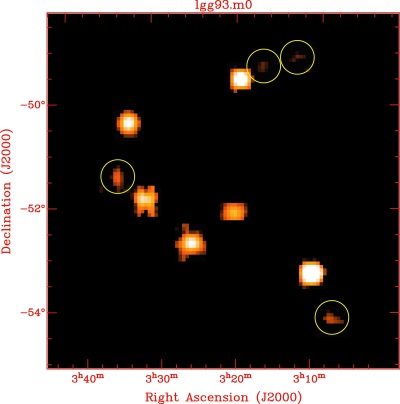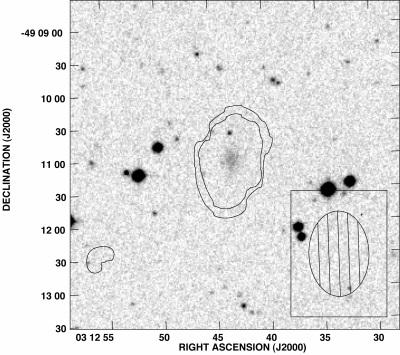What and where are the High-Velocity Clouds around the Milky Way?
|
D.J. Pisano (ATNF); Brad Gibson (Swinburne University of Technology); David Barnes (University of Melbourne); Lister Staveley-Smith (ATNF); Ken Freeman (Research School of Astronomy and Astrophysics, Australian National University); Virginia Kilborn (Swinburne University of Technology/ATNF) Over 40 years ago, astronomers discovered clouds of neutral hydrogen (HI) around the Milky Way moving at velocities inconsistent with Galactic rotation; these clouds were termed high-velocity clouds or HVCs. Because HVCs are not in simple Galactic rotation and have no associated stars, it has been impossible to determine their distances and, hence, their masses. Without such basic information, astronomers have been limited to indirect methods to infer the origin of HVCs. Today, it appears that a variety of processes can explain the origin of HVCs, and that they, perhaps, reside over a large range in distance. Some HVCs are probably related to a Galactic fountain. A Galactic fountain occurs when a number of supernovae in the disk of our Galaxy explode in close proximity over a short period of time. The combined energy of the explosions lifts the interstellar gas into the halo of our Galaxy, where it cools and rains back onto the disk. In this scenario, HVCs are the cooling gas falling back onto our Galaxy, residing in the near Galactic halo, only tens of thousands of parsecs from the disk. Some HVCs are certainly tidal in origin. The Magellanic Stream is the most prominent tidal feature in the sky, a tidal tail created by the interaction between the Large and Small Magellanic Clouds and the Milky Way. Because of its association with the Magellanic Clouds, the Stream is known to be located at a distance of approximately 55,000 parsecs. Other HVCs may be related to the accretion of the Sagittarius dwarf galaxy or other satellite galaxies by the Milky Way and would reside at similar distances. One of the original ideas as to the nature of HVCs was that they are infalling primordial gas contributing to the formation of the Milky Way. These clouds would have low metallicities, having not been enriched by supernovae, and may be located either near or far from the Milky Way. At least one large HVC complex has a measured low metallicity and a distance of at least 5000 parsecs. The idea that HVCs reside at very large distances, about one million parsecs from the Milky Way, is nearly as old as the discovery of HVCs themselves. Originally, this idea was dismissed because their inferred HI masses would not be large enough for HVCs to be stable. Recently, this idea has undergone a refinement. Leo Blitz and collaborators, as well as Robert Braun and Butler Burton, have proposed that at least some of the HVCs are associated with dark matter halos and reside at distances of up to a million parsecs from the Milky Way, and contain of order 10 million solar masses of HI. Current models of hierarchical galaxy formation predict that the Local Group should contain roughly 300 low mass, dark matter halos; an order of magnitude higher than the number of known luminous dwarf galaxies. This is commonly known as the missing satellite problem. If the HVCs reside within the excess dark matter halos, then the total number of HVCs and dwarf galaxies matches the predictions of simulations, thus solving the problem. In this case, HVCs are the building blocks for the continued assembly of the galaxies contained within the Local Group. This scenario is easily tested: if HVCs are associated with galaxy and group formation, then their analogues will be visible in other groups of galaxies similar to the Local Group. If no HVC analogues are detected, then limits on their masses and their distances can be inferred. Over the past three years Pisano and his collaborators have been using the Parkes multibeam instrument to search for HVC analogues in six loose groups of galaxies similar to the Local Group in structure and morphology. A loose group is a collection of a few large galaxies and tens of smaller galaxies that are separated by a distance much larger than the size of individual galaxies and spread over a diameter of approximately one million parsecs. The groups observed contained only spiral galaxies, just like the Local Group. The observations were sensitive to clouds with HI masses down to 10 million solar masses. An example is shown in Figure 1, which shows a map of the total HI intensity in the LGG 93 group. All Parkes HI detections were confirmed with follow-up Compact Array observations which also provided better spatial resolution to search for optical counterparts. In the three groups for which the Parkes detections have been confirmed, ten new HI-rich dwarf galaxies were detected. An example of two of these dwarf galaxies is shown in Figure 2. The Compact Array observations had the same sensitivity as the Parkes data, so even if an HI cloud was unresolved by Parkes, it would have been detected with the Compact Array. Nevertheless, no HI clouds without stars, HVC analogues, were found in the three groups using either telescope. The non-detection of HVC analogues in these three groups allows constraints to be placed on the masses of the clouds. If the HI clouds in the target groups have the same properties as the HVCs seen around the Milky Way, then a failure to detect them implies that the average HI mass of HVCs is less than 400,000 solar masses, and the clouds must be clustered within 160,000 parsecs of the Milky Way and the group galaxies. These limits are in good agreement with recent models and inferred distances to HVCs around the Milky Way made by other astronomers using a variety of different methods. They firmly rule out the original models of Blitz and collaborators and Braun & Burton, which place HVCs at a distance of one million parsecs. It does not mean that HVCs lack dark matter, but only that they are tightly clustered around galaxies and contain much less mass than these authors originally believed. Overall, this has profound implications for the importance of HVCs in the Local Group. Namely, the total HI mass in HVCs is less than 100 million solar masses; roughly equivalent to a single gas-rich dwarf galaxy. As such, there is very little neutral matter in HVCs present in the selected groups or the Local Group that is available for accretion by the large galaxies to fuel future star formation. Furthermore, because HVCs must be tightly clustered around the Milky Way, they are not so much associated with the formation of the Local Group, but more with the formation of individual galaxies if they do contain dark matter. Unfortunately, future searches for HVC analogues in other groups to further constrain their nature will be very difficult due to the extreme sensitivity required. These observations will probably have to wait for the next generation of radio telescopes. |
|



